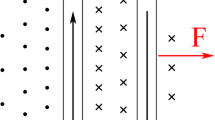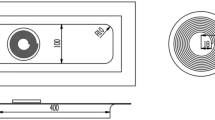Abstract
Electromagnetic forming is a forming method that employs the electromagnetic force to accomplish deformation of metal workpiece and is greatly suitable for high conductivity metals. Therefore, for the alloy with high conductivity such as aluminum, direct electromagnetic forming method is commonly used. However, for some low-conductivity workpieces such as stainless steel and titanium, the electromagnetic force generated on the workpiece is small, which is not enough to shape the workpiece. Drive forming method is usually used to solve this problem. This method employs a high conductivity metal as the drive plate and generates a large Lorentz force on the drive plate to form the low conductivity metal. This paper uses drive forming method to improve the forming result of aluminum alloy. Copper is used as the drive plate. By simulation and experiment, the mechanism of the drive forming and the effect of the size of the drive plate, the thickness of the workpiece, and discharge frequency on forming result are studied. It is found that the drive plate slows down the deformation speed and enhances the action between the coil and the forming part, which results in a higher Lorentz force. Compared with direct electromagnetic forming, the drive forming with appropriate parameters can effectively increase the forming height and improve the uniformity of the forming contour, especially when the discharge frequency is low or the thickness of workpiece is relatively thin.





















Similar content being viewed by others
Data availability
The authors confirm that the data supporting the findings of this study are available within the article.
References
Golovashchenko SF (2007) Material formability and coil design in electromagnetic forming. J Mater Eng Perform 16:314–320. https://doi.org/10.1007/s11665-007-9058-7
Seth M, Vohnout VJ, Daehn GS (2005) Formability of steel sheet in high velocity impact. J Mater Process Tech 168:390–400. https://doi.org/10.1016/j.jmatprotec.2004.08.032
Li F, Mo J, Li J, Huang L, Zhou H, Qiu L (2015) Experimental and numerical investigation of electromagnetic bulging of titanium alloy Ti-6Al-4V at room temperature. P I Mech Eeng B-J Eng 229:1753–1763. https://doi.org/10.1177/0954405414539296
Psyk V, Risch D, Kinsey BL, Tekkaya AE, Kleiner M (2011) Electromagnetic forming-a review. J Mater Process Tech 211:787–829. https://doi.org/10.1016/j.jmatprotec.2010.12.012
Cao Q, Du L, Li Z, Lai Z, Li Z, Chen M, Li X, Xu S, Chen Q, Han X, Li L (2019) Investigation of the Lorentz-force-driven sheet metal stamping process for cylindrical cup forming. J Mater Process Tech 271:532–541. https://doi.org/10.1016/j.jmatprotec.2019.03.002
Huang L, Zhang J, Zou J, Zhou Y, Qiu L (2019) Effect of equivalent radius of drive coil on forming depth in electromagnetic sheet free bulging. Int J Appl Electrom 61:377–389. https://doi.org/10.3233/Jae-190009
Shin C (2008) Expansion of a low conductive metal tube by an electromagnetic forming process: Finite element modeling. Met Mater Int 14:91–97. https://doi.org/10.3365/met.mat.2008.02.091
Li F, Mo J, Li J, Huang L, Zhou H (2013) Formability of Ti–6Al–4V titanium alloy sheet in magnetic pulse bulging. Mater Des 52:337–344. https://doi.org/10.1016/j.matdes.2013.05.064
Park H, Kim D, Lee J, Kim S-J, Lee Y, Moon YH (2016) Effect of an aluminum driver sheet on the electromagnetic forming of DP780 steel sheet. J Mater Process Tech 235:158–170. https://doi.org/10.1016/j.jmatprotec.2016.04.023
Xu J, Zhou Y, Cui J, Huang L, Zhang X, Li G (2017) Effects of temperature and driver sheet for magnesium alloy sheet in magnetic pulse forming. Int J Adv Manuf Tech 95:3319–3333. https://doi.org/10.1007/s00170-017-1423-6
Huang L, Ding Z, Zhou Y, Zeng J, Zou J (2020) Effect of the radial dimension of the driver sheet on the electromagnetic driven forming. IEEE Access 8:133503–133513. https://doi.org/10.1109/Access.2020.3010000
Liu X, Huang L, Su H, Ma F, Li J (2018) Comparative research on the rebound effect in direct electromagnetic forming and indirect electromagnetic forming with an elastic medium. Materials. https://doi.org/10.3390/ma11081450
Huang L, Ding Z, Zeng J, Zhou Y, Sun Q (2021) Optimization of the coupled cooling circuit in electromagnetic forming with finite element analysis. Int J Adv Manuf Tech 116:2211–2221. https://doi.org/10.1007/s00170-021-07525-1
Cao Q, Han X, Lai Z, Xiong Q, Zhang X, Chen Q, Xiao H, Li L (2015) Analysis and reduction of coil temperature rise in electromagnetic forming. J Mater Process Tech 225:185–194. https://doi.org/10.1016/j.jmatprotec.2015.02.006
Kuo CL, You JS, Hwang SF (2011) Temperature effect on electromagnetic forming process by finite element analysis. Int J Appl Electrom 35:25–37. https://doi.org/10.3233/JAE-2011-1319
Wu S, Ju K, Duan C, Kong J (2019) Dynamic mechanical properties and constitutive model of fine-grained T2 copper. Tool Eng 53:16–20. https://doi.org/10.3969/j.issn.1000-7008.2019.11.004
Xiong Q, Zhao X, Zhou H, Yang M, Zhou L, Gao D, Li S (2021) A triple-coil electromagnetic two-step forming method for tube fitting. Int J Adv Manuf Tech 116:3905–3915. https://doi.org/10.1007/s00170-021-07693-0
Qiu L, Wang B, Abu-Siada A, Xiong Q, Zhang W, Ge W, Liu C, Jiang L, Wang C (2020) Research on forming efficiency in double-sheet electromagnetic forming process. IEEE Access 8:19248–19255. https://doi.org/10.1109/access.2020.2968049
Funding
This work was supported in part by the National Natural Science Foundation of China 51607152 and the Interdisciplinary Program of Wuhan National High Magnetic Field Center (Grant No.WHMFC202118).
Author information
Authors and Affiliations
Contributions
Lantao Huang and Wengjing Feng were responsible for simulation and experiment. Lantao Huang, Wengjing Feng, and Jin Zeng were involved in the discussion and significantly contributed to making the final draft of the article. All the authors read and approved the final manuscript.
Corresponding author
Ethics declarations
Ethics approval
Not applicable.
Consent to participate
Not applicable.
Consent for publication
Not applicable.
Competing interests
The authors declare no competing interests.
Additional information
Publisher's Note
Springer Nature remains neutral with regard to jurisdictional claims in published maps and institutional affiliations.
Rights and permissions
About this article
Cite this article
Huang, L., Feng, W., Zeng, J. et al. Research on the drive electromagnetic forming of aluminum alloy and parameter optimization. Int J Adv Manuf Technol 120, 7101–7113 (2022). https://doi.org/10.1007/s00170-022-09214-z
Received:
Accepted:
Published:
Issue Date:
DOI: https://doi.org/10.1007/s00170-022-09214-z




